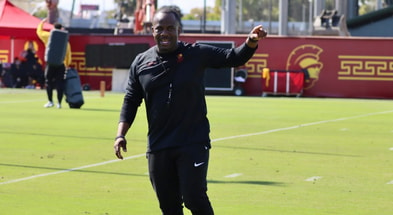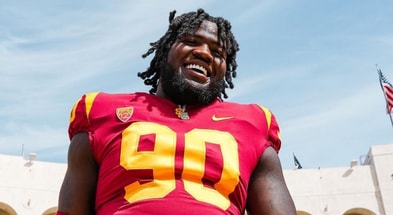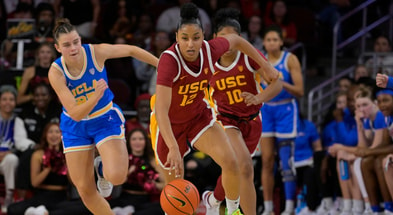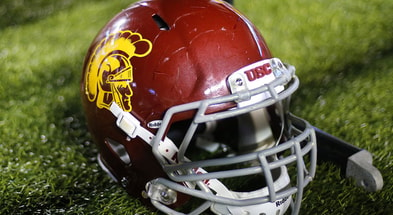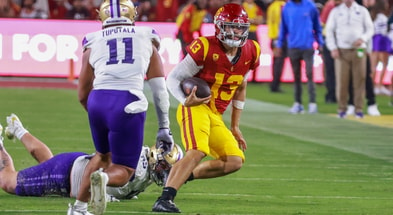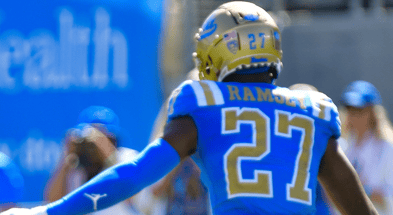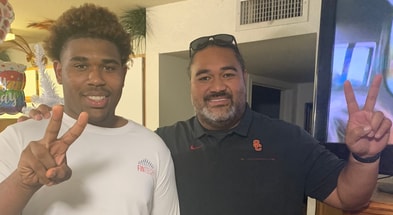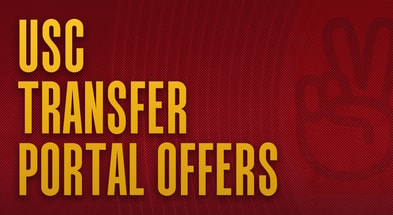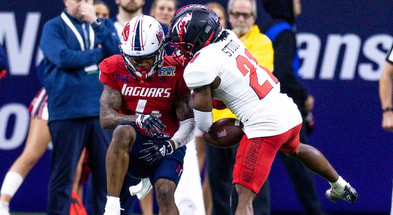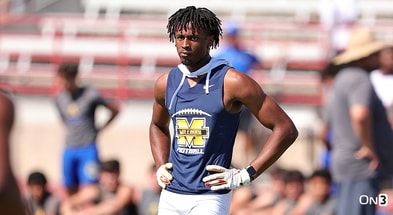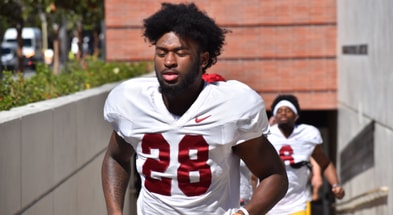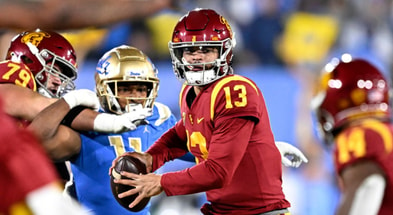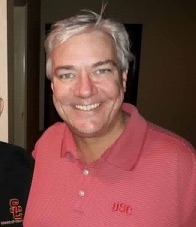Musings from Arledge: Slovis, Punting, Dear Oklahoma, and a Great Night at the Coliseum
Being wrong feels amazing. I now understand why so many people I know try it so often. I thought that Stanford was going to out-physical USC. At the end of the first quarter, it was obvious I was right.
And then.
What a great night at the Coliseum. The most fun I’ve had there in years.
Of all the things to like about that Stanford game (editorial note: should we be referring to it as a “game” or its more technical term, “merciless curb stomping?”), maybe the thing I liked best is the mental toughness and resiliency it took for the Trojans to come back from a pretty ugly first 17 minutes. Down 14-3, the defense looks completely unprepared to deal with Stanford’s physicality, and you lose a fumble on the kickoff. That’s when bad teams die. I’ve accused USC of being a mentally and physically soft program – I was right about that, by the way – and last year’s team probably would have rolled over in that situation. But this group of guys sucked it up, forced Stanford to kick a field goal, and then bludgeoned the Cardinal 42-3 the rest of the night. Amazing.
Of course, you can’t talk about that game without talking about The Slov. (I think somebody gave him that nickname once.) Why didn’t anybody warn us? Why couldn’t the coaching staff have made some outrageously over-the-top comments about how great this kid is so we could be mentally prepared for what we were about to see? Yes, it’s only one game; Slovis is a freshman; he will make some freshman mistakes; every week won’t be as easy as this week; he hasn’t done it on the road yet. I know all that. You know all that. But we also know this kid is special. True freshmen quarterbacks simply don’t do that in their first career starts. This Stanford team probably isn’t David Shaw’s best. But they’re tough, disciplined, and they have some playmakers, including an all-world corner. And Kedon Slovis calmly rode his bike to the Coliseum, baseball card in the spokes making a cool noise the entire way, put his high school letter jacket and retainer in his locker, walked out onto one of the most-storied grounds in American sports, and methodically did that heart removal trick from The Temple of Doom. That’s the worst beating anybody from Stanford has taken since that band kid got run over by the Cal guy in the end zone that time.
I feel for JT Daniels. That injury was a tough break. I wish him the very best. He will no doubt work hard, come back healthy, start at QB, and play well. I just don’t think he’ll be doing it at USC. Dude just got Wally Pipped.
USC’s season turned around in 2016 when Sam Darnold took over. That 2016 team probably goes 6-6 if Sam doesn’t work his magic. But football teams are sometimes like that, and when a new star rises up at the most important position, sometimes it makes everybody better and changes the entire complexion of the season. Is that what we saw the other night? We still need a game or two to know for sure, but I think the answer might be yes.
How one night can change perspectives. I thought it took real guts for the USC coaching staff to put Slovis number two on the depth chart. That made some USC fans very unhappy and left a lot of the rest of us very confused. But after watching Slovis play like that, it appears that the coaching staff might have been overly cautious. That is the best a USC QB has looked since Sam Darnold, and most weeks Sam Darnold didn’t play that well. The kid is good.
Yes, Graham Harrell earned his paycheck in week two. That is exactly what I had hoped USC’s offense would look like when the Kliff Kingsbury announcement was made. But Harrell is going to be getting a lot of praise from a lot of people, and I’m not yet ready for him to become a hot head-coaching prospect, so let’s talk about a couple of other coaches that deserve some kudos.
Let’s start with Tim Drevno. His embattled offensive line group more than held against Stanford. Stanford may not have any top-notch edge rushers this year, so we’ll have to see how USC deals with guys like that later in the season. But Stanford is tough and physical, and USC’s offensive line more than took care of business. With this group of backs and receivers, it was always clear that USC would go as far as its offensive line would take it. After two weeks, it looks like that offensive line may take this team farther than a lot of us thought possible.
In fact, the O line made strides even in the area of USC’s biggest weakness. The short-yardage offense has been a mess for a few years now. I think USC has converted two third and one plays on the ground since 2010. (I’m having the research staff verify that stat.) My concern with the move to the Air Raid was whether USC would make this critical problem even worse. Air Raid teams like Wazzu run when the other team is playing nickel or dime and looking pass; they often struggle to run when the other team knows they must. But against Stanford, USC was 3 for 6 trying to run for a first down with two yards of less to go. The Trojans also ran the ball into the end zone twice on first and goal, once from the four and once from the six.
These aren’t all-world numbers, obviously; this team isn’t going to run the ball like ‘72 USC or ‘95 Nebraska. But these are reasonable numbers considering how bad USC has been in these situations in recent years and just how much a third and short run plays into Stanford’s strengths as a defense. I think we have reason to be encouraged.
(Give the ball to Markese Stepp in these situations and we may have a lot more reason to celebrate.)
And how about Greg Burns and his young secondary? It’s true that Stanford’s QB handed out a few favors missing passes he should have hit. But that doesn’t change the fact that those young defensive backs are competing, seem to know their assignments, and are starting to get their hands on the football. Those guys should get better every week, and after the abuse they took from their teammates in fall camp — admittedly, that is a dominant group of wideouts – this strong play is a very pleasant surprise.
A few final notes on the game:
Too many penalties last night. You may have been distracted by Kedon Slovis giving David Shaw a wedgie at midfield, so you may not have noticed, but USC had way too many significant penalties last night. They need to clean that up. It will cost them in a tighter game.
I love Vavae; I think he’s a really good football player. But he has 35 carries so far this year, and Carr and Stepp have combined for 15. Now maybe there’s a reason unrelated to carrying the football why Vavae is getting the most time. Running the ball is not all that a running back has to do. Maybe Vavae is doing other things that Carr and Stepp are unable or unwilling to do. I don’t know. But purely as a runner, as good as Vavae is, he’s the third-best back on the team. Carr is far more elusive, and Stepp is like that giant boulder that chased Indiana Jones – don’t even think about stopping it; just get out of the way. So no offense intended to Vavae, who is good, but giving him 70% of the carries seems odd.
Don’t sleep on BYU. USC is more talented, but winning at Provo isn’t easy, and after their comeback win on the road against Tennessee, BYU is going to come in with some swagger and confidence. And all the good feelings and momentum from Stanford disappear if the Trojans don’t come ready to play next week. I think they will.
It was nice to see some fellow WeAreSCers before the game. Erik McKinney, CP619, TroJack, and Troy70 were all there. TroJack said we had absolutely nothing to worry about with Stanford. I thought he was nuts. Shows what I know. Maybe TroJack should guest write Musings sometime so you guys can read something that makes sense for once.
Let’s assume for a second that this Air Raid success is more than a one-night wonder. With the O line improvement, elite skill position talent, and a rising star at QB, I think the offense is going to be a force. This should allow Clancy to call games more aggressively on defense. If you have the 2018 offense, you have to keep the opposing offense to a small number, and you can’t let them get out to a lead and make the offense one-dimensional. But if you trust the offense, you can play far more aggressively on defense. You can afford to blitz aggressively and leave your corners isolated. Your secondary can play tighter and attempt to jump underneath routes. Simply put, you don’t have to be perfect, and because you don’t have to be perfect, you can apply more pressure on the opposing offense. You might give up more big plays with this approach, buy you’re likely to cause a lot more big plays of your own, especially sacks and turnovers.
Oregon did this very well under Chip Kelly, back before Kelly turned into Paul Hackett with worse recruiting skills. Oregon’s offense was so explosive that opposing offenses felt pressure to score touchdowns on every possession. So they pressed. Meanwhile, Oregon attacked aggressively on defense. And it didn’t take much to get the result they needed. Get a sack on one drive to cause a punt, then get an interception two series later, and all the sudden it’s 35-14 and the game is over. If USC’s offense does what I think it’s capable of doing, it will take the pressure off the defense and allow the defense to play very fast and very aggressive.
USC didn’t do a lot of punting against Stanford, but I’ve been noodling over the punting game since that opener. Very little surprised me about the Fresno State game, but there was one thing I found very surprising: our new Aussie punter, who had become an internet legend and folk hero before ever taking the field, looked pedestrian. Based on comments after the game, it appears that his high, short kicks were a part of the game plan. I want to explore for a second whether such a strategy makes sense.
I want to start by recognizing that football, more than most sports, is lacking in the analytics department. It has been obvious for a long time, for example, that most coaches are too conservative about going for it on fourth down – Clay Helton being an exception, ironically – but old habits die hard. And the kicking game is always the unwanted stepchild of football analysis, so getting empirical data on a question like this is difficult. I therefore enter the fray with some trepidation.
But there are a few things we know for sure. The first is that starting field position has a significant effect on points scored. There’s more data from the NFL than college football, and the calculations vary a little depending on source, but it seems pretty clear that each 10 yards in field position makes a difference in expected points of between .6 and 1.0 points per possession. Thus, a team that starts at its own 25 is expected to score .25 points on that drive, whereas if the team starts on its own 35, it is expected to score just under 1 point on that drive. The difference between starting at your own 25 and opposed to your own 40 is the same expected value as a missed extra point. That’s meaningful over the long run.
Of course, punting the ball a long way doesn’t necessarily mean the receiving team will start deep in its own end. A great gross punt may not end up being a great net punt. But it appears that each additional yard in gross punting is going to get you on average about half a yard in net punting. (Again, these are NFL figures.) So going from 37 yards a punt to 47 yards a punt will usually result in a net increase of about five yards on your punt, or somewhere between .3 and .5 expected points.
These are averages, of course. But we’ve all seen how impactful it is when a great punter flips the field. When a team expected to start around their own 40 or 45 gets stuck at their own 20 after a great punt, it can have a massive effect on the game. When you give up the ability to flip the field in that way, you’re giving up something substantial.
And what are you getting back? You’re avoiding a big return by the other team. Punt return touchdowns are devastating and obviously something to avoid. But how often do they happen? Let’s look at some of the great punt returners of all time. Rocket Ismail had 25 punt returns in college and scored only 1 TD. (And had a second called back in the national title game. Ha!) Desmond Howard had 26 returns in college and only 1 TD. Reggie Bush had 44 punt returns and 3 TD’s. And keep in mind, these are just the punts they returned, which as a rule are the plays where there is room to maneuver. They went back to receive far more punts than this.
I can still see the argument that you should not punt the ball to Rocket, Desmond, or Reggie. But note that even with those guys, punt return TD’s are a rare thing. USC punted 65 times in 2018. That’s too many, of course, but let’s say they cut that down to 50 punts. If you give up 5 to 6 yards in field position on each punt, you give up 250 yards over the course of the season, which is equivalent to about 20 points. If you’re punting to Reggie Bush, this is probably a worthwhile tradeoff, since he ran back 1/15 of his returned punts, and probably around 1/30 of his attempted punt returns, which translates to about .2 points per return. But even refusing to punt deep to Reggie is questionable statistically.
And that brings us to the Fresno State game. Unless Fresno had Reggie or Rocket back returning punts, it makes almost no sense to me that you would give up the ability to pin the other side deep merely to avoid a return TD that is highly unlikely. I just don’t think that strategy makes very much sense.
Free Ben Griffiths!
Dear Oklahoma Sooners,
I’m not a fan of your program. I did not attend OU, and I’ve obviously never donated anything to your team or school. And, yes, I did laugh at you a lot during that Orange Bowl game and I’m sorry, but you have to admit it would have taken a very strong man, a very good man, not to. Besides, you bounced back and got on your feet again, so you really shouldn’t be holding any grudges over that kind of thing. So I just have a small favor to ask. If you don’t have too big of a problem with pummeling the weak and defenseless, could you put up 100 next week? I’d really appreciate it. Asking for a friend.
I know I should probably stop, but I can’t let it go. On the way to the game, I turned the radio to the UCLA station to get a score update, and I got there just in time to hear the Bruin homer announcers talking about how all quarterbacks can struggle sometimes. Aaron Rodgers once went 9 for 34. I don’t know if that stat is true or not; not sure I care. What I am sure of is UCLA doesn’t have an Aaron Rodgers in hiding at the QB position.
The ineptitude in Westwood is shocking. Oregon State is embarrassed for these guys. We’ve seen high-profile, can’t-miss coaches fail to meet expectations before. But I’m not sure I’ve ever seen one go 3-11 before. (Soon to be 3-13 with OU and Wazzu up next.) Chip Kelly – always the innovator.
(I’m thinking of writing a movie script, a remake of Twins, this time with college football coaches. Chip Kelly will be my star, the Danny Devito twin from an unholy combination of Paul Hackett and Hodor. If it’s a hit – how can it not be? – I’ll do a remake of Rudy where the movie actually features the truth.)
One game doesn’t make a season. USC and Clay Helton didn’t get into their current situations because of one bad night, and one good night isn’t enough to say that the program is back. But it was a very good night, and there is reason for hope. Our guys need to take care of business in Provo and set up the Pac 12’s game of the year.
